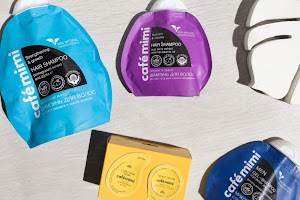 |
| 3 simple recipes for vegan clay masks |
Since I try to live in the spirit of less waste, I have stopped buying face masks and I try to do them at home. Clay masks have fantastic purifying properties and each type of clay has additional advantages. In addition, mixed with other ingredients, they can give completely different results than the clay with water alone. Today, I will tell you what kind of clay to choose for which skin and I will show you 3 simple recipes for masks that you can make from easily accessible ingredients that you may have in your kitchen ;).
How to choose a clay?
White clay - a delicate clay, has soothing, nourishing and moisturizing properties, smoothes and slightly pores the pores. Suitable for all skin types that are even prone to allergies and inflammation.
Yellow clay - is distinguished by a high iron content, has anti-inflammatory, cleansing and regenerating properties. It improves skin elasticity, smoothes and tightens pores. It is recommended for mixed, oily, acne and mature skin due to its revitalizing properties.
Red clay - seals the blood vessels, evens and warms the skin tone, moisturizes and smoothes it. Cleans the complexion and absorbs excess sebum. It soothes the symptoms of rosacea. It is recommended for oily, acne, mixed and capillaries skin.
Pink clay - is a combination of white and red clay. It soothes irritations, gently pulls pores, nourishes and smoothes the skin. Like red clay, it shrinks the blood vessels. It is suitable for vascular skin, dry and sensitive skin, and even skin prone to irritation.
Moroccan clay (ghassoul) - cleanses, mattes and refreshes the skin. It infects inflammation and absorbs excess serum. Suitable for all skin types, especially for combination skin, oily skin and acne.
Green clay - the most popular of clays, has purifying and astringent properties. It has a disinfectant and supports skin regeneration. It is especially recommended for oily, acne and mixed skin.
Blue clay - this clay has the strongest cleansing effect. Deeply penetrates the pores, cleanses and visibly reduces. It is not recommended for sensitive skin, it works well in the care of acne, mixed and oily skin.
Black clay - has antiseptic, cleansing and anti-inflammatory properties. Moisturizes the skin and supports its regeneration. Works well in the care of acne skin.
What to know about using clays:
- Don’t mix clay with a metal spoon. Unfortunately, when clays come in contact with metal they lose their properties.
- While wearing a mask made of clay, it’s worth spraying the face with hydrolate or ordinary water, then you don’t give clay to dry and avoid irritated, tightened complexion.
- You can use clay mask 1-2 times a week, if you have dry or sensitive skin is recommended to apply a moisting cream after washing the mask.
- You don’t have to apply clay to the whole face, you can apply it only to problematic areas or use two different clays, for example red clay for reddness and green or blue clay for clogged pores.
- Remember that clays can also be sensitized. It is worth checking if you don’t have allergies to the clay or other ingredient. It's good to put it on your hand for a few minutes and see if this place has turned red.
Recipe I:
Clay - 1 tbsp
Rose water / hydrolate - 1-1.5 tbsp
Gel / aloe juice - ½ tsp
Oil - 10 drops
Essential oil - 2 drops (optional)
Recipe II:
Clay - 1 tbsp
Spirulina - tsp
Rose water / hydrolate - 1-1.5 tbsp
Gel / aloe juice - ½ tsp
Oil - 10 drops
Essential oil - 2 drops (optional)
Recipe III:
Clay - 1 tbsp
Cocoa - ½ tsp
Rose water / hydrolate - 1-1.5 tbsp
Gel / aloe juice - ½ tsp
Oil - 10 drops
Essential oil - 2 drops (optional)
Preparation:
Mix all ingredients in a glass or ceramic bowl with wooden or plastic spoon to obtain a smooth, creamy consistency. If the mask comes out too thick, you can add water or hydrolate, or if it comes out too thin, you can add clay. Put on the mask for 10-15 minutes. After this time, wash it with water.
As you can see, this recipe is simple and doesn’t require a lot of ingredients. You can use ordinary filtered water for its preparation, but you will get better results using hydrolate or rose water, which has moisturizing properties. I usually add a hydrolate that I use (most often it is a rose hydrolate). The gel or aloe juice has strong moisturizing and regenerating properties, so it will moisturize the skin and help in the fight against imperfections. If you add oil to the mask, it won’t dry out quickly and will also moisturise the complexion. You can add oil that you are currently using for beauty care or a bit of ordinary olive oil or other unrefined oil that you have in the kitchen (I often use ordinary olive oil). For the second recipe, I added spirulina, which is a rich source of vitamins. Moisturizes the skin, gives it a silky softness and improves its elasticity and firmness. In turn to the third recipe I added cocoa, which has moisturizing, nourishing and soothing effects. It also softens the skin and increases its elasticity.
Optionally you can add essential oils to the masks.
For dry skin, lavender oil is recommended
For normal skin - lavender and lemon
For mature skin - ylang-ylang, orange, lemon
For oily skin - lavender, lemon, orange, ylang-ylang and rosemary
For acne skin - lavender, tea tree oil, lemon, ylang-ylang
Do you make face masks at home? What clay is your favorite?
xoxo,
Dorota










No comments:
Post a Comment